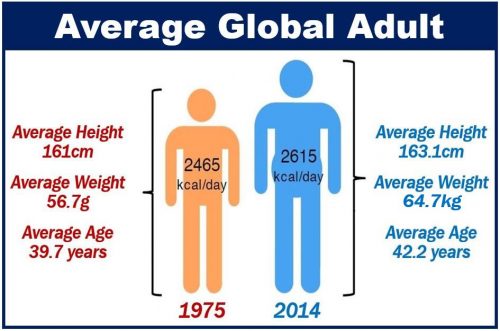Feeding 9 billion people in the future will be more difficult than we had previously thought. In the future, people will be heavier, larger, and will eat more than people today. In other words, the average human in the future will be consuming more calories per day than people do now. This is what three researchers in Norway say after carrying out a study.
Gibran Vita said:
“It will be harder to feed 9 billion people in 2050 than it would be today.”
Vita is a PhD candidate at the Norwegian University of Science and Technology’s Industrial Ecology Programme.
Felipe Vásquez, Gibran Vita, and Daniel B. Müller wrote about their study and findings in the journal Sustainability (citation below). They are all from the Industrial Ecology Programme, Norwegian University of Science and Technology’s Department of Energy and Process Engineering.
The world’s greatest environmental problem, says the WWF, is the destruction of animal and plant habitats. WWF stands for the World Wide Fund for Nature.
Much of that destruction is due to the demands of the human population, which have been steadily growing.
The UN Sustainable Development’s goal is to achieve ‘Zero Hunger.’ Its major challenge is to supply enough food for growing global food demand.
In economics, ‘demand‘ refers to a measure of desire or need to have, own, or consume products or services. In this article, it refers to the level of desire or need to consume food.

Feeding 9 billion people
The world’s population is approximately 7.6 billion. It will probably level off at about 9 billion at some time in the near future.
The average human in the future, however, will need more food than today. We’ll be needing more, partly because of our changing eating habits, increases in BMI and height, and demographic transitions. Our attitudes towards food waste are also partly responsible.
BMI stands for body mass index. It is a measure that uses a person’s height and weight to determine whether their weight is healthy. A BMI above 25 and 30 means a person is overweight or obese (respectively).
The authors analyzed changes in the human populations of 186 nations. They focused on the period between 1975 and 2014.
Feeding the average person today and before
Vita said:
“We studied the effects of two phenomena. One is that people on average have become taller and heavier. The second is that the average population is getting older.”
The first phenomenon that Vita mentioned contributes to food demand. The second, to a certain extent, counteracts the first.
- 1.3% taller.
- 14% heavier.
- 6.2% older.
The average person in 2014 also required 6.1% more energy than in 1975. For most countries, this trend will continue.
Energy consumption of human adults
Regarding our daily consumption of kilocalories, Vita said:
“An average global adult consumed 2465 kilocalories per day in 1975. In 2014, the average adult consumed 2615 kilocalories.”
From 1975 to 2014, human food consumption grew by 129%. People’s greater height and weight accounted for 15% of this increase, while population growth accounted for 116%.
While older people need less food, an aging population results in just 2% lower consumption.
Regarding the additional people, Vásquez said:
“The additional 13 percent corresponds to the needs of 286 million people.”
This corresponds approximately to the combined food requirements of Scandinavia and Indonesia.
Trends in countries vary considerably
Weight gains and energy requirement increases from 1975 to 2014 varied significantly from country-to-country. During this period, the changes ranged from:
- 6% to 33% regarding weight gain per person.
- 0.9% to 16% regarding increased energy requirement per person.
The average person in Tonga and Vietnam weighs 93kg and 52kg respectively. People in Tonga, therefore, require 800 more kilocalories per day that Vietnamese people. This is the equivalent in calories of two bowls of oatmeal.
Some nations are changing rapidly. The average weight of people in Santa Lucia, for example, increased from 62kg in 1975 to 82kg in 2014.
The smallest and greatest changes over this period are found in Asia and Africa. Hence, the disparities between countries in these two continents.
Feeding 9 billion people – size and lifespans
Regarding the calculation of feeding the world population in the future, Vásquez said:
“Previous studies haven’t taken the increased demands of larger individuals and aged societies into account when calculating the future food needs of a growing population.”
Most studies estimating the feeding of 9 billion people assumed adult’s needs would remain constant over time. Researchers had also assumed that the factors determining food needs would be fairly similar across nations. However, this is not the case.
Vásquez said:
“These assumptions can lead to errors in assessing how much food we’ll actually need to meet future demand.”
The authors say that their findings provide relevant information for FAO. FAO stands for the Food and Agriculture Organization. The FAO is a specialized United Nations agency that leads international efforts to defeat hunger.
If we want to understand the mechanisms behind human food consumption, we must look at more than just population numbers. We need to take a multidisciplinary approach. Specifically, one that considers both social and physiological factors.
This study’s analysis involved a hybrid of biology and demography. In other words, ‘bio-demography.’
Citation
“Food Security for an Aging and Heavier Population,” Felipe Vásquez, Gibran Vita, and Daniel B. Müller. Sustainability 2018, 10(10), 3683. DOI: https://doi.org/10.3390/su10103683.
